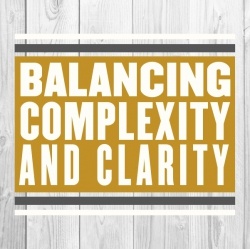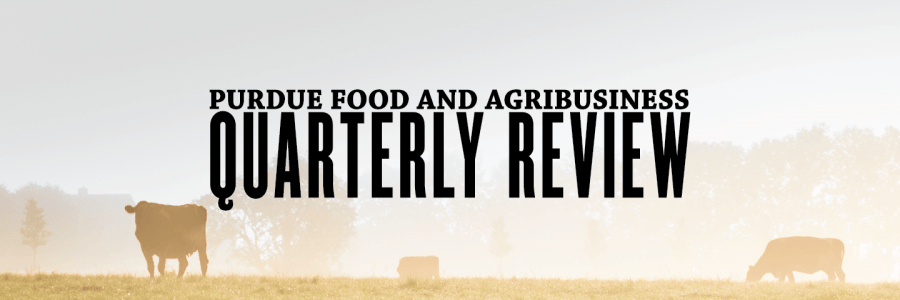Balancing complexity and clarity
 Article
Article
Dobni, C. B., M. Klassen, D. Sands. “Getting to Clarity: New Ways to Think About Strategy.” Journal of Business Strategy. 37(5)2016.
Reviewer
Dr. Allan Gray, Executive Director and Professor
Summary
The authors explore the balance between complexity and clarity in a company’s strategy. The authors note that in today’s world the competitive environment is more complex and interdependent. They argue that in a complex environment a company should be striving for clarity in their business strategy to create value.
What this means for food and agricultural businesses
Arguing that today’s food and agriculture environment is more complex and interdependent is not difficult. The globalization of the food demand chain has heightened the interdependence between global suppliers, merchandisers and retailers to new levels. In addition, the diversifying demands of consumers as incomes rise has increased the complexity of the marketplace dramatically—whether we are talking about increased animal protein demand in developing countries or the increase in credence attributes of food in rich countries. Couple these complexities with the shifting climate patterns and the resulting fluctuations in agricultural productivity and becomes increasingly difficult to develop and follow long-term strategies using our historical strategy frameworks.
 Figure 1. Clarity Framework. Adapted from Figure 1 “Getting to Clarity: New Ways to Think About Strategy.”
Figure 1. Clarity Framework. Adapted from Figure 1 “Getting to Clarity: New Ways to Think About Strategy.”
Dobni and her co-authors argue in this paper that company leaders should pursue simplicity and clarity in their strategy in times like those we are facing in our industry today. Their clarity framework, shown in Figure 1, illustrates the need to focus on five key questions and a set of associated clarity actions. The five key questions we should be asking are:
Can managers articulate the strategy? The authors in this report suggest that we should be able to agree on the primary value driver in our organization or clearly articulate our competitive advantage. Yet, most of us struggle with this and therefore run the risk of losing focus on the things that truly drive value in our companies. How well do the managers in our organization really understand our strategy? More importantly, can they clearly synthesize our strategy in 35 words or less? While it might seem straightforward to create these statements, it never ceases to amaze me how much we struggle to get to this level of strategic clarity. If we, as managers, can’t be clear about our strategy, how will our employees and customers be clear about our strategy?
Are we able to recognize shifting opportunities? The unpredictability of markets and competition within the food and agricultural industries increasingly results in the blurring of industry boundaries; and, the profit pools that exist in the industry can shift rapidly. To operate in this environment requires us to move much quicker to capture advantages. The tried and true concepts of building sustainable advantages over a period might not be good enough in this environment. The key is to be able to act on real opportunities in real time. The authors in this paper suggest we should be asking: “Is our strategic position clear enough?” and “Does our strategy have clear tactics on how to compete?” Answering these questions would allow us to execute on real opportunities when they arise at a much faster pace.
What is the fault line? This paper suggests that we must be able to determine the one thing that could alter the fate of the business. For example, what technology may be on the horizon that will dramatically reshape the industry? Is there a critical shift in customer behavior that will shift the value proposition for the industry? What regulatory changes are on the horizon that could fundamentally alter the cost structure of the industry? Identifying these potential fault lines is critical to developing strategic clarity around where we may need to shift the focus of our strategy.
Is the status quo satisfactory? The authors suggest that status quo thinking is a high-risk approach to the business. In unpredictable and volatile markets like agriculture, it is tempting to take a defensive position that seeks to protect our current market position. The problem with this approach, as we have all seen before, is that while we are busy protecting our position, our most keen competitors are actively seeking opportunities to grow, developing new business models that redefine the competitive game, and/or adopting new technologies that reposition them in the competitive landscape. We need to resist the temptation to hide our head in the sand when industry turbulence rises.
What is our approach to innovation? This paper argues that innovation is the best example of high growth-low risk strategy. Leaders that can create a culture that supports novel thinking, asks new questions about old problems, motivates employees to think or act differently can unlock market value on a more consistent basis. Certainly, in the market we face in food and agriculture today the innovators are the ones reshaping the industry from the digital farming innovators, to the niche market creators in the food industry. Those of us more inclined to want to stick to the “tried and true” are increasingly at risk of looking up and finding that we have been innovated out of our own industry.
Challenging ourselves to address the five questions listed here is the key to getting clarity to our strategy. Clarity will allow us to understand when we might need to enhance or shift the focus of our current strategy. Strategic clarity can open up the areas where strategy execution has been lacking and where innovative behaviors may need to be encouraged. Finally, not only does getting to strategic clarity help us define the actions we should be pursuing but will also lead to important outcomes for the firm including: higher growth with lower risk; value and capital growth; improvement in strategic agility and dynamic capabilities; a more innovative culture; and competitive advantages that shift more seamlessly as markets shift. In the unpredictable environment of food and agriculture simplifying and clarifying our strategy seems a prudent choice to me.
RELATED POSTS:
A great moment for value-based sales in agribusiness
Value-based sales can empower companies to craft compelling value propositions, understand the customer’s business model and effectively communicate to stakeholders.
How can big data empower the development of new products?
Data is one of the most powerful resources for a company. It enables accurate decision-making and minimizes risk, ensuring greater revenue and sustainable growth.
Unlocking Growth: Exploring innovation dynamics in the agrifood sector
The future for the agrifood sector appears promising, driven by technological advances, strategic M&A activity and a growing commitment to innovation.

